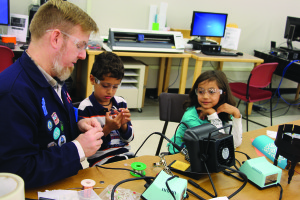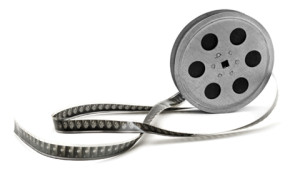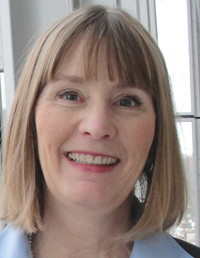The maker movement and makerspaces have swept the country and grown in numbers in libraries in recent years, as communities and libraries work to support science, technology, engineering, arts, and mathematics education by offering spaces and equipment where users can learn as they create.

American Libraries spoke to representatives from three library makerspaces—Megan Danak, principal librarian at Tampa–Hillsborough County (Fla.) Public Library System’s The Hive; Sarah Winchowky, project coordinator at the Free Library of Philadelphia’s Maker Jawn; and Innisfil (Ont.) Public Library’s Aaron DeVries, ideaLAB manager, and Susan Downs, CEO—about their makerspaces, the lessons they’ve learned about facilitating making in the library, and what they can see about the future of the maker movement and makerspaces as a more widely expected part of library service.
Each of your libraries has a unique brand for its makerspace. How did you develop the space’s identity, and how has it been received by your users?
DANAK: Our main library building has a façade made of recycled pipes in the shape of a hexagon. In our planning process, we made jokes about being worker bees and having a hive mind. It’s really easy to use the Hive name in an engaging way—we want it to create a buzz, and it’s a hive of activity. We’ve had a really positive response to it.
WINCHOWKY: “Jawn” is a context-dependent substitute noun that comes from the Philadelphia hip-hop scene and can replace basically any noun. The library wanted something up to date but specific to Philadelphia. We wanted people to come and tinker and not have rigidity to the space. It was difficult at first because many of our school-age users had always been told what to do. Now they love it—there’s an unbounded energy that comes out of the Maker Jawn.
DOWNS: We were renovating our largest branch, and we discovered one day that that building needed a new roof. We were able to move into a former drugstore, and in that environment we started to do things differently.
DEVRIES: We put a new name—ideaLAB—and logo on the building. We intentionally didn’t have “library” on the building at first. When we first had 3D printing in our branches, there were a lot of questions about why it was in a library. When we dedicated space to it and gave it equal status to collections, people stopped questioning it, and they realize how the makerspace and the library can be married.
How are makerspaces like yours changing users’ perceptions of the library?
DANAK: There’s a lot of push toward entrepreneurial culture in Tampa, but I wasn’t expecting so much of the business community to be so interested. Inventors and businesspeople are asking about making prototypes on our machines. The makerspace has a lot of firsts for us in terms of technology, and the first thing that comes out of most people’s mouths is, “I never thought this would be in the library.”
DOWNS: We like the idea of the community kitchen, where everyone is creating and discussing and arguing together. That’s engaged the people who walk through the door and it’s created a very different environment than the transactional model of library service that has dominated library thinking for the past 50 years.
How have you worked to engage volunteers to help facilitate making, and what has surprised you about working with community members in this way?
WINCHOWKY: We don’t necessarily have a big contingent of volunteers who apply through the volunteer office. But we have people who have been coming to maker programs for a while, and they act as volunteers because they can help other newer makers. We have informal graduated categories so that people who know how to use something can help other people who don’t, and we’re also working on a badging system when people have learned the processes for using a piece of equipment.

DEVRIES: Anyone who’s comfortable in the space is going to become a go-to person for her niche. We’ve seen that happen in both our hackerspace and the digital media lab—the superstars who are just hanging out with the stuff engage with new people who are just coming to see it for the first time.
DOWNS: We see that as so valuable we don’t want to endanger it by over-formalizing it. That sharing is special, and if we put up a lot of rules and position descriptions, we might lose it.
How has the maker movement allowed you to reach out to potential partners? Are there any particular challenges to working with them?
DANAK: The technology is exciting, but we’re fortunate in that a lot of what’s going into the space already exists in the community. For example, we’re giving a venue to the existing local robotics community through our robotics center. We’ve been trying to make it a space where the community drives what the programming is, rather than the library saying “We’re going to do this.” We allow the public to book our space, and we’re able to reach partners who need a space and show them the resources the library has to offer. We do have some restrictions in how people can use the space, which can be a challenge. For example, they can’t charge for events, which some nonprofits want to do. We’re working within existing policies and seeing if we may need to adapt them in the future.
WINCHOWKY: We’ve connected with local groups like the Philadelphia Youth Network, as well as national groups like the Maker Education Initiative. Having partners throughout the city and in different parts of the country helps us to be more useful to patrons and makers—we can connect them to opportunities they may not have otherwise had. Not all organizations have the same goals, so you have to work together to figure out how a partnership can meet the goals of all the partners.
How do you determine what programs and technologies to introduce?
DANAK: We’re kind of getting our feet under us in terms of what we have, with a recording lab, digital studio, Adobe software, and 3D printer. We’re seeking feedback all the time and hoping to tailor services to what the public wants.
WINCHOWKY: We have several methods: periodically reviewing the needs and interests of the makers, polling maker mentors, collecting suggestions from staff and local and national partners, and responding to new initiatives from the local government or school districts. We’ve expanded the program into six neighborhood libraries, with an IMLS National Leadership Grant helping to fund three of them. Due to the increase in library sites, we’ve had to begin more formal documentation so we know where our equipment is and the information that is in our staff’s heads. It’s not meant to create a rigid “curriculum,” but it allows others to see what we offer.
DOWNS: We had a shotgun approach at the beginning, after visiting several makerspaces, but we’ve realized we need to think in terms of more specific categories.
DEVRIES: Our HackerLab has four categories: 3D design (including 3D printers, design software, and eventually computer numerical control (CNC) manufacturing equipment), vector projects (laser cutting and etching and vinyl cutting), electronics and coding (programming, web design, Arduino, and Raspberry Pi), and arts and crafts (ranging from knitting and quilting to performance). Within those headings, we’re working on learning what people most respond to.

What equipment or technology are you looking forward to introducing?
WINCHOWKY: We recently received a grant for intergenerational work. Our audience has typically been school age, but the IMLS National Leadership Grant will help us to get families and other library patrons involved in maker programming.
DEVRIES: One area I’m excited about is electronics and coding. We’ve often talked about the importance of learning code, but we haven’t done much until now. There are great organizations in our area that we’re excited to work with as partners.
What do you think is next in the maker movement for libraries?
DANAK: Libraries have always had maker programs, even if they weren’t called that. But the perception is going to change as these programs expand. I think that as people come to expect this from a library, it’s going to change the face of what we do. It will be like STEM education, which we’ve now written into our plans because our community expects us to support it.
WINCHOWKY: Not all learning comes out of a book, and libraries looking to have the maker movement flourish need to embrace the informal learning that’s taking place. Making is not always quiet or orderly or clean. You also don’t need big, fancy equipment in a dedicated space to have a successful program. We’re on the floor with the patrons right in the library.
DOWNS: We decided we couldn’t build our space on technolust, and we started thinking in terms of critical making and emphasizing STEM (or STEAM) programs. We think that creating an environment for the community to engage in is the next big thing. Formal buildings can sometimes lead to formal behaviors that can inhibit learning. We’ve changed some job titles and job descriptions because they can be limiting—we now have resident tinkerers and artists-in-residence, and we let them try new things that come with those new titles.


